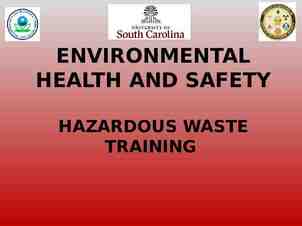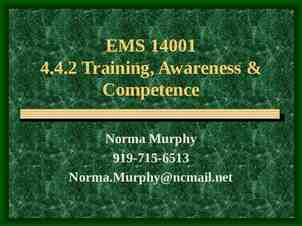Flammable and Combustible Liquids Presented by Martina
18 Slides3.04 MB
Flammable and Combustible Liquids Presented by Martina Schmeling Adapted From OSHA
Introduction The two primary hazards associated with flammable and combustible liquids are explosion and fire Safe handling and storage of flammable liquids requires the use of approved equipment and practices per OSHA standards
Flash Point Flash point means the minimum temperature at which a liquid gives off enough vapor to form an ignitable mixture In general, the lower the flash point, the greater the hazard Flammable liquids have flash points below 100oF, and are more dangerous than combustible liquids, since they may be ignited at room temperature Combustible liquids have flash points at or above 100oF Although combustible liquids have higher flash points than flammable liquids, they can pose serious fire and/or explosion hazards when heated
Flash Point (oF) Classes of Flammable and Combustible Liquids 200 IIIA 140 Combustible (FP 100oF) II 100 IC 73 IA IB 100 Boiling Point (oF) Flammable (FP 100oF)
Classes of Some Flammable Liquids Common Name Flash Point (oF) CLASS IA Ethyl Ether -49 CLASS IB Gasoline -45 Methyl Ethyl Ketone 21 Toluene 40 Xylene 81-115 Turpentine 95 CLASS IC
A good plan for safe use of flammable and combustible liquids contains at least these components: Control of ignition sources Proper storage Fire control Safe handling
Sources of Ignition Must take adequate precautions to prevent ignition of flammable vapors. Some sources of ignition include: Open flames Smoking Static electricity Cutting and welding Hot surfaces Electrical and mechanical sparks Lightning
Static Electricity Generated when a fluid flows through a pipe or from an opening into a tank Main hazards are fire and explosion from sparks containing enough energy to ignite flammable vapors Bonding or grounding of flammable liquid containers is necessary to prevent static electricity from causing a spark
Ventilation Always provide adequate ventilation to reduce the potential for ignition of flammable vapors.
Safety Cans for Storage and Transfer Approved container of not more than 5 gallons capacity Spring-closing lid and spout cover Safely relieves internal pressure when exposed to fire
Flame Arrester Screen Prevents fire flashback into can contents Double wire-mesh construction Large surface area provides rapid dissipation of heat from fire so that vapor temperature inside can remains below ignition point
Fire Control Suitable fire control devices, such as small hose or portable fire extinguishers must be available where flammable or combustible liquids are stored Open flames and smoking must not be permitted in these storage areas Materials which react with water must not be stored in the same room with flammable or combustible liquids
Transferring Flammable Liquids Since there is a sizeable risk whenever flammable liquids are handled, OSHA allows only four methods for transferring these materials: 1. Through a closed piping system 2. From safety cans 3. By gravity through an approved self-closing safety faucet 4. By means of a safety pump
Self-Closing Safety Faucet Bonding wire between drum and container Grounding wire between drum and ground Safety vent in drum
Safety Pump Faster and safer than using a faucet Spills less likely No separate safety vents in drum required Installed directly in drum bung opening Some pump hoses have integral bonding wires
Waste and Residue Combustible waste and residue must be kept to a minimum, stored in covered metal receptacles and disposed of daily. Waste drum with disposal funnel Safety disposal can Oily-waste can (self-closing lid)
Safe Handling Fundamentals Carefully read the manufacturer’s label on the flammable liquid container before storing or using it Practice good housekeeping in flammable liquid storage areas Clean up spills immediately, then place the cleanup rags in a covered metal container Only use approved metal safety containers or original manufacturer’s container to store flammable liquids Keep the containers closed when not in use and store away from exits or passageways Use flammable liquids only where there is plenty of ventilation Keep flammable liquids away from ignition sources such as open flames, sparks, smoking, cutting, welding, etc.
Summary The two primary hazards associated with flammable and combustible liquids are explosion and fire Safe handling and storage of flammable liquids requires the use of approved equipment and practices per OSHA standards An excellent reference on this topic is National Fire Protection Association Standard No. 30, Flammable and Combustible Liquids Code























